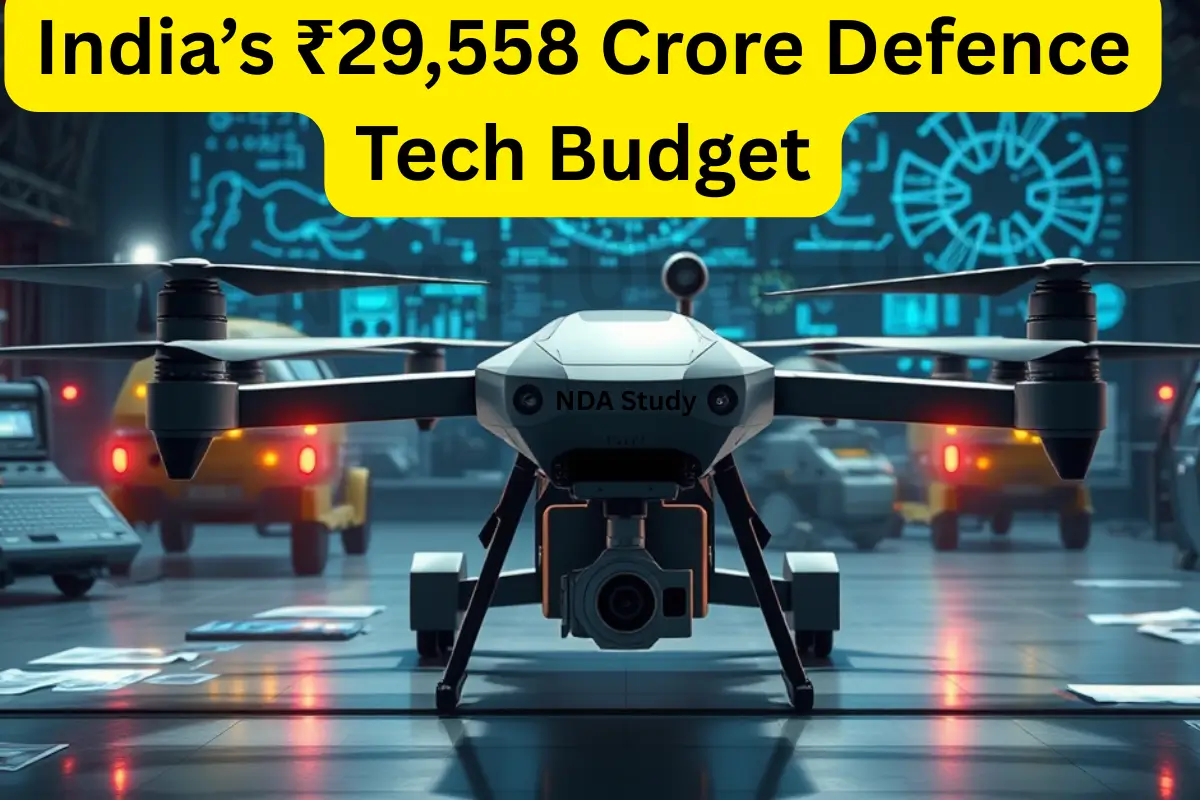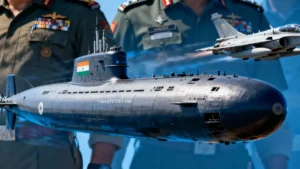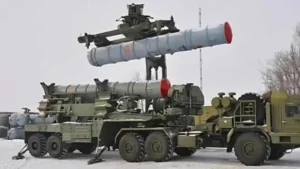India’s ₹29558 Crore Defence Tech Budget marks a historic milestone, unleashing unprecedented funding over three years to power indigenous defence innovation. This massive investment, channelled through DRDO and key industry partners, is a bold step that propels India’s Aatmanirbhar Bharat and Make in India Defence missions into overdrive. With ₹29,558 crore committed to cutting-edge projects, this strategic budget not only boosts self-reliance in military technology but also unlocks new career opportunities for youth, defence aspirants, and industry stakeholders. As India sharpens its technological edge to safeguard national security and assert global stature, this game-changing budget promises transformative impact across research, manufacturing, and defence readiness—capturing the imagination of every defence enthusiast and advancing the nation’s sovereign strength.
Overview of India’s ₹29558 Crore Defence Tech Budget Sanction
India’s ₹29,558 crore defence technology budget is a significant investment aimed at enhancing the country’s indigenous defence capabilities. This funding will support over 100 transformative projects from 2023 to mid-2025, facilitating crucial research, prototype development, and rigorous testing before moving into production. Led by the Defence Research and Development Organisation (DRDO) and its industrial partners, the initiative encompasses various domains, including aerospace engines, next-generation unmanned aerial vehicles (UAVs), combat aerial vehicles (UCAVs), missile systems, radar and electronic warfare technologies, as well as advanced defence electronics essential for national security and technological independence.
Here is the detailed year-wise breakdown of the approved sanction and the number of projects it supports:
| Year | Funding Allocation (Rs Crore) | Number of Projects |
|---|---|---|
| 2023 | ₹3,842.71 Crore | 40 Projects |
| 2024 | ₹22,175.49 Crore | 43 Projects |
| 2025* | ₹3,540.46 Crore | 20 Projects (ongoing & approved) |
The sharply phased and escalating budget clearly signals the government’s aggressive push to reduce import dependency and position India as a leader in defence technology innovations. The increase from ₹3,842 crore in 2023 to over ₹22,000 crore in 2024 reflects a significant ramp-up phase aimed at delivering operational capabilities swiftly.
What makes this budget particularly intriguing are the specific breakthroughs and technologies it supports, which promise to redefine India's military preparedness. Additionally, it offers exciting career and industrial opportunities for youth, start-ups, and the defence manufacturing sector. The ripple effects of these investments are expected to extend beyond defence, boosting high-tech industries and reinforcing India’s self-reliance on the global stage.
Kaveri Derivative Engine (KDE) & Its Strategic Importance
India’s ₹29,558 crore defence technology budget is driving a significant advancement in indigenous propulsion, particularly highlighted by the ambitious Kaveri Derivative Engine (KDE) program. The KDE is a ‘dry’ turbofan engine—meaning it operates without an afterburner—specifically designed for Unmanned Combat Aerial Vehicles (UCAVs), such as the upcoming Ghatak stealth drone. With a thrust rating between 48 and 51 kN, this engine is engineered for long-endurance missions that require high fuel efficiency and stealth due to its low infrared signature.
This powerplant marks a crucial step toward India’s long-desired independence from imported aero-engines, addressing a critical vulnerability in both peacetime and crises. By equipping India’s next-generation stealth UCAVs, the KDE is set to enhance deep-penetration and precision strike capabilities in hostile airspace, significantly boosting operational autonomy and force projection for the Indian military. The government’s substantial investment has also fostered dynamic civil-military partnerships; leading manufacturers such as Godrej Aerospace are now integral to the development and production process, signalling the growth of India’s defence-industrial ecosystem.
The technical journey of the KDE builds on the legacy of the original Kaveri engine, which, despite early challenges, provided a technological foundation that has now been revitalised with advanced design, materials, and digital control systems. Rigorous ground and initial flight trials are currently underway, with the first full-scale flight scheduled on a dedicated test bed within the next three to four years. Looking ahead, the KDE will not only empower the Ghatak UCAV but is also being positioned as the basis for future enhancements, including afterburner-equipped variants that could eventually power India’s advanced manned fighter jets.
This strategic indigenous program, supported by the ₹29,558 crore budget, embodies the spirit of Aatmanirbhar Bharat and signals India’s intention to dominate the evolving landscape of aerial warfare technology. As the KDE progresses toward certification and operational deployment, its ripple effects will extend beyond military platforms—fostering innovation, creating jobs, and enhancing export potential, while also inspiring the next generation of aerospace engineers and technologists in India.
Civil-Military Synergy & Industry Collaboration
India’s ₹29558 crore defence tech budget is driving a significant wave of civil-military cooperation through innovative partnerships and open industry collaboration. An essential part of this initiative is the DRDO’s Development-cum-Production Partners (DcPP) program, which connects private industry early in the development process, enabling the rapid conversion of prototypes into mass-produced, deployable solutions. This approach significantly reduces traditional lead times. Moreover, the DRDO’s Industry-Academia Centres of Excellence (DIA-CoEs) have been established at 15 leading institutes across the country.
Also read:
India’s Indigenous Pollution Control Vessel Samudra Prachet Launched by GSL [2025 Exclusive ]
How Kerala’s British F-35B Jet Became a Meme Sensation—And Flew Home After a Month
Pakistan Closes Entire Airspace Amid Missile Test or Military Drill? – Exclusive Expose
Is Pakistan Preparing for Conflict ? NOTAM Raises Red Flags in Central Air Command
BREAKING: India to Test Advanced Counter-Satellite Weapon — Defence Space Agency’s Bold New Step
These centres actively involve startups, MSMEs, research universities, and students in high-impact defence R&D. They create a collaborative ecosystem where academic expertise, student energy, and industry efficiency come together to drive innovation in critical areas such as advanced materials, artificial intelligence, unmanned aerial vehicles (UAVs), and defence electronics. By working with regulatory bodies like CEMILAC and DGCA, India is streamlining the military-civilian UAV certification process. This effort unlocks dual-use technology and accelerates the introduction of new products to both the armed forces and commercial markets. Pro-industry government policies—such as zero technology transfer fees, no royalties, and incentives related to the Defence Industrial Corridor—make it easier and more cost-effective for emerging players to participate in this thriving sector.
“Bold strategies are forging India’s defence tech ecosystem, driving innovation and job creation.”
NDA Study
Broader Government Strategy and Impact
India’s ₹29,558 crore defence technology budget is a key part of the Aatmanirbhar Bharat vision, which aims to accelerate the country’s journey towards self-reliance and significantly reduce defence imports. By focusing on domestic research and development (R&D), manufacturing, and advanced innovation, this funding enhances research cycles and helps cultivate a strong homegrown defence ecosystem. It also ensures that cutting-edge technologies move swiftly from labs to field deployment, improving India’s strategic autonomy and preparedness against evolving threats.
The broader impact of this investment is significant: new defence technologies create a ripple effect that drives economic benefits, including the creation of high-value jobs, increased exports of indigenous military platforms, and positive spillovers into sectors such as aerospace, electronics, artificial intelligence, and materials science. With over 75% of procurement budgets now allocated for domestic sources, India is solidifying its position as both a regional and global security provider while promoting a culture of innovation and industrial growth across various sectors. As global competition intensifies and grey-zone threats rise, this strategic investment is crucial for enhancing national security, fostering technological advancement, and positioning India as a rising leader in the global defence export market.
1. What is the significance of India’s ₹29,558 Crore Defence Tech Budget approved by the government?.
India’s ₹29,558 Crore Defence Tech Budget is a transformational investment aimed at boosting indigenous defence technology development over three years via DRDO and industry partners. This budget accelerates India’s self-reliance mission under the Aatmanirbhar Bharat and Make in India Defence initiatives. It funds over 100 advanced projects, including aerospace engines, UAVs, missile systems, and electronic warfare technologies, significantly reducing import dependency and enhancing national security readiness. This funding also fosters innovation, job creation, and technology spillovers into civilian sectors, marking a new era of defence modernisation and strategic autonomy for India.
2. Which key projects are funded under the ₹29,558 Crore Defence Tech Budget, and what are their objectives?
The budget supports a spectrum of cutting-edge projects, including research, prototype development, flight testing, and production transition phases. Key among these is the Kaveri Derivative Engine (KDE), a dry turbofan engine for India’s next-gen stealth UCAVs such as the Ghatak drone, enabling deep penetration and precision strike abilities. Other projects cover missile systems, radar tech, electronics, and advanced aerospace technologies. The goal is to fast-track indigenous innovation and enhance India’s defence manufacturing base while forging strong civil-military partnerships.
3. How does the Development-cum-Production Partners (DcPP) initiative accelerate defence technology deployment?
The DcPP initiative engages private industry early to fast-track prototype development into serial production, significantly reducing traditionally long development and procurement cycles. By fostering partnerships among DRDO, startups, MSMEs, and academia, DcPP enhances collaboration and innovation in critical defence sectors. This synergy, combined with government policies like zero technology transfer fees and no royalty charges, boosts manufacturing capabilities within Defence Industrial Corridors and supports India’s goal of defence self-reliance.
4. What are the career opportunities arising from this massive budget boost in indigenous defence technology?
India’s ₹29,558 Crore budget is opening dynamic career paths in defence R&D, aerospace engineering, drone design, propulsion systems, and defence manufacturing. Expanded government initiatives encourage youth and professionals to join DRDO, private startups, and MSMEs, fostering skills development and job creation in high-technology areas. This surge empowers defence aspirants to contribute to national security while benefiting from emerging opportunities in one of India’s fastest-growing and strategically critical sectors.
5. What are the expected ripple effects of India’s ₹29,558 Crore Defence Tech Budget beyond military applications?
Beyond military modernisation, this budget drives technology spillovers into civilian applications such as commercial aerospace engines, energy turbines, automotive components, and high-tech manufacturing. Indigenous propulsion and materials technologies enhance industrial capability and economic growth. Strategically, it strengthens India’s geopolitical standing by reducing foreign dependencies and nurturing defence exports like drone engines and UCAV systems to allied nations. The ongoing evolution of flagship projects like the Kaveri engine family positions India for sustained innovation in aerospace and unmanned warfare.
Technology Spillovers and Future Prospects
India’s ₹29,558 crore defence technology budget is not only boosting military advancements but also driving significant technological spillovers into civilian sectors, such as aerospace, energy (including turbines), automotive, and high-tech manufacturing. Innovations developed for defence—like advanced propulsion systems, materials, and control technologies—are increasingly being adapted for commercial aerospace engines, power generation turbines, and automotive components. This process is enhancing India’s industrial capabilities and contributing to economic growth.
Strategically, these indigenous innovations enhance India’s geopolitical standing by reducing reliance on foreign technology and arms imports, thereby strengthening national sovereignty and security. Additionally, India is positioning itself as an exporter of cutting-edge defence technologies, including drone engines and Unmanned Combat Aerial Vehicles (UCAVs), to friendly and allied countries, which opens new diplomatic and economic opportunities.
Looking ahead, the Kaveri engine family is expected to evolve further, with advanced variants potentially powering future fifth-generation fighter jets and sustaining India’s innovation in unmanned aerial vehicles (UAVs). This continuous development ensures that India’s aerospace propulsion technologies remain at the forefront, aligning with the broader vision of self-reliance and strategic autonomy that underpins the ₹29,558 crore defence technology investment.
Author’s Word
India’s recent funding injection of Rs 29,558 crore is a game-changer for the country’s indigenous defence technology ecosystem. This initiative propels innovations from research labs to the battlefield and strengthens self-reliance in line with the Aatmanirbhar Bharat vision. The transformative budget accelerates defence research and development, fosters cutting-edge technologies like the Kaveri Derivative Engine, and supports a vibrant partnership between civil and military manufacturing.
For defence enthusiasts, aspirants, and professionals, this moment represents a pivotal opportunity for career growth and development. Stay connected with NDA Study for the latest expert analyses, continuous updates, and insightful career guidance as India embarks on its dynamic journey in defence technology. Don’t miss our upcoming articles that will delve deeper into defence innovation trends, aerospace advancements, and pathways to build a future in India’s defence sector. Follow us to stay at the forefront of India’s march toward defence self-reliance and technological superiority.
Stay Tuned & Stay Connected!












